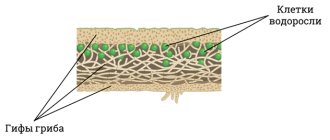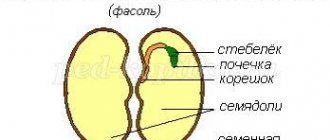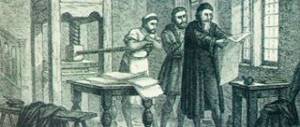DNA determination
Nucleic acids are high molecular weight linear polymers. Since the content of nucleic acids is greatest in the nucleus, they got their name from the Latin word nucleus (“core”, lat.). However, nucleic acids are contained not only in the nucleus, where, of course, they are most abundant, but also in chloroplasts and mitochondria (Fig. 1).
Rice. 1. Organelles that contain DNA
Nucleic acids are biopolymers that consist of monomers - nucleotides. A nucleotide molecule consists of three components: a five-carbon sugar - pentose, a nitrogenous base and a phosphoric acid residue (Fig. 2).
Rice. 2. Nucleotides
The sugar contained in the nucleotide is a pentose, that is, it is a five-carbon sugar. Depending on the type of pentose (deoxyribose or ribose), DNA and RNA molecules are distinguished (Fig. 3).
Rice. 3. Chemical composition of nucleotides
Nitrogenous bases . All types of nucleic acids: DNA or RNA, contain four different types of bases (Fig. 4). In DNA: adenine (A), guanine (G), cytosine (C) and thymine (T). In RNA, instead of thymine (T), there is uracil (U).
Rice. 4. Nitrogen bases of DNA and RNA nucleotides
Phosphoric acid. Nucleic acids are acids because they contain a phosphoric acid residue. Please note that the phosphoric acid residue is attached to the sugar at the hydroxyl group of the 3' and 5' carbon atom (Fig. 5).
Rice. 5 Phosphodiester linkage between individual nucleotides in a nucleic acid chain
This is very important for understanding how nucleotides form nucleic acid. They connect to each other using the so-called. phosphodiester bond.
Development of a biology lesson on the topic “Nucleic acids” (grade 10)
Biology teacher Beksultanova Aset Alievna,
GBOU "Presidential Lyceum"
Biology 10th grade
Lesson topic: “Nucleic acids.”
The purpose of the lesson:
introduce students to nucleic acids.
Lesson objectives:
- Educational
:
characterize the structural features of nucleic acid molecules as biopolymers;
- reveal the role of nucleic acids in the storage and transmission of hereditary information.
:
- develop general educational skills;
:
- to cultivate in students a culture of communication and work during conversations, watching presentations and animated films, and completing assignments;
Lesson type:
combined.
Equipment:
multimedia complex.
LESSON PLAN
1. Organizational moment
(1-2 min.)
2. Updating previously studied material
(5-7min.)
- The cell is the smallest and most elementary unit of structure and vital activity of all living organisms. Cell organelles (slide 1)
- Organic and inorganic substances in the cell (slide 2)
- Lesson topic: “Nucleic acids”
3. Presentation of new material
(20-25min.)
- Types of nucleic acids (slide 3)
- Structure of a DNA molecule (slides 5)
- The structure of nucleotides of a DNA molecule (slides 6, 7,

- The combination of nitrogenous bases in a DNA molecule. The principle of complementarity (slide 9)
- Connection of polynucleotide chains (slide 10)
- Dimensions of a DNA molecule (slide 11)
- The structure of ribonucleic acid. Comparison of DNA and RNA molecules (slides 12, 13)
- Types of RNA. The relationship between DNA and RNA molecules in a cell (slides 14, 15, 16)
4. Consolidation
- Solving the problem of complementarity in the DNA molecule (slide 17) (5 min.)
- Filling out the table “Comparison of DNA and RNA molecules” (slide 18) (5 min.)
5. Homework
(1 min.)
DURING THE CLASSES
I. Updating previously studied material
Slide 1. Cell. Cell organelles.
The topic of the lesson is closed. To determine it, let’s remember what is the smallest and most elementary unit of life on earth?
– Cell
Name the organelles that make up the cell (the teacher moves the mouse cursor to the organelle, and the children name them; clicking the mouse reveals the answers).
– Nucleus, mitochondria, endoplasmic reticulum, ribosomes, lysosomes
Slide 2. Nucleic acids.
The topic is still closed from students. The teacher asks to name the substances that make up the cell - water, mineral salts, proteins, fats, carbohydrates, nucleic acids
What two groups can all these substances be divided into?
– Organic and inorganic
Next, students distribute the substances they named into groups: “Organic and inorganic substances”
– Organic: proteins, fats, carbohydrates, nucleic acids Inorganic: water, mineral salts.
Students then discover that they have not yet studied nucleic acids. The topic of the lesson is announced: “Nucleic acids”
II. Presentation of new material
Slide 3. Types of nucleic acids
Nucleic acids are natural high-molecular organic compounds that ensure the storage and transmission of hereditary information in living organisms. A diagram is shown showing that there are two types of nucleic acids: DNA (deoxyribonucleic acid) and RNA (ribonucleic acid). They were discovered by the Swiss chemist I.F. Miescher in the nuclei of leukocytes. On the slide you can see a photograph of Miescher.
Slide 4. DNA structure.
The structure of DNA was modeled in 1953 in the USA by scientists F. Crick and D. Watson. Students are shown a model of DNA and learn that nucleic acids contain chemical elements such as carbon, oxygen, nitrogen and phosphorus.
Slide 5. DNA structure.
Children look at a 3D model of DNA, which can be seen from all sides. The question arises: “What can you tell about the DNA molecule by looking at the model?” – The DNA model is a double-stranded helix twisted around its own axis.
The following question appears: “What is the structural element of a polymer?”
– Monomer
Next, students remember what are monomers of organic substances: proteins, fats, carbohydrates?
Protein monomers – amino acids; Monomers of carbohydrates - monosaccharides; Lipid monomers are glycerol and fatty acids.
And the monomer of nucleic acids are
nucleotides
. Slide 6. Nucleotides are monomers of nucleic acids.
Children see the definition: “Nucleotide”
A nucleotide is a chemical compound consisting of residues of three substances: a nitrogenous base, a pentaatomic sugar and phosphoric acid.
The following demonstrates the classification of nitrogenous bases that make up nucleic acids (purine bases - adenine and guanine, pyrimidine bases - cytosine, thymine and uracil)
Slide 7. Structure of DNA nucleotides
The slide shows the four types of nucleotides that make up DNA.
Question: “How are nucleotides different from each other and how are they similar?”
– They differ in nitrogen base, but are similar in the content of deoxyribose and phosphoric acid.
Slide 8. Structure of nucleotides.
Children watch a video clip that once again shows purine and pyrimidine nitrogenous bases. DNA is a double helix, therefore, the nucleotides of two DNA chains are connected through nitrogenous bases by hydrogen bonds: A=T, G?C. A large number of hydrogen bonds ensures the strength of the connection of DNA strands and maintains its mobility.
Slide 9. Compounds of nitrogenous bases
The concept of “complementarity principle” is introduced. Students remember the video they watched earlier and answer questions. The nitrogenous base A (adenine) of one polynucleotide chain is always connected by two hydrogen bonds with T (thymine), and G (guanine) is always connected by three hydrogen bonds with C (cytosine) of the opposite polynucleotide chain. (A) is complementary to (T), and (D) is complementary to (C), that is, they fit together like a key to a lock.
Next, students remember what bonds arise between nitrogenous bases?
– Hydrogen.
(In the figure, these connections are highlighted in color)
Slide 10. Compounds of DNA polynucleotide chains
Students look at a diagram of the structure of a DNA molecule. Name the components of a nucleotide
– Deoxyribose, phosphoric acid residue, nitrogenous base (A, T, G or C).
Once again, hydrogen bonds are found in the molecule. And they note that there are also connections in the molecule between the carbohydrate of one nucleotide and the phosphoric acid residue of the neighboring nucleotide. The teacher explains that these are strong phosphodiester bonds.
Slide 11. DNA molecule
The double helix of DNA is demonstrated. Children's attention is drawn to the fact that sugar-phosphate groups of nucleotides are located on the outside, and complementary bound nucleotides are located on the inside. Nucleotide chains form right-handed voluminous helices of 10 base pairs in each turn. The diameter of the DNA double helix is 2 nm, the pitch of the common helix (which contains 10 pairs of nucleotides) is 3.4 nm.
Slide 12. Types of nucleic acids
Students remember that in addition to DNA, there is another nucleic acid - RNA. Throughout the slide there is a comparison of DNA and RNA molecules. Students themselves note that the RNA molecule, unlike DNA, is single-stranded, and is also a polymer, the monomer of which is a nucleotide.
Slide 13. Continuation of slide 12.
The teacher demonstrates that RNA contains the carbohydrate ribose, and the nitrogenous base U (uracil) instead of T (thymine). Therefore, in an RNA molecule A=U, G?C.
Slide 14. Types of RNA
The slide shows the types of RNA: messenger RNA (i-RNA), transfer RNA (t-RNA), ribosomal RNA (r-RNA)
Slide 15. Children watch a video clip from which they learn:
- where DNA and RNA molecules are located in a cell;
- what relationship exists between these nucleic acids;
- what role does the DNA molecule and each of the three types of RNA molecules play in the cell
Slide 16. The role of RNA in the cell.
The teacher asks the question: “Remember the video fragment. What role do i-RNA, t-RNA and r-RNA play in the cell?
- mRNA reads information from a section of DNA about the primary structure of the protein and carries this information to the ribosomes
- tRNA transports amino acids to the site of protein synthesis - ribosomes
- rRNA is part of ribosomes.
Slide 17. Reinforcing the material learned
Children define “complementarity.” They are asked to complete the second strand of DNA using the principle of complementarity, knowing the sequence of nucleotides in the first strand. 1st strand of DNA: G-T-C-T-A-C-G-A-T…
2nd strand of DNA: C-A-G-A-T-G-C-T-A...
Slide 18. Similarities and differences of nucleic acids
Students fill out the table based on the knowledge gained during the lesson or using the textbook.
Phosphodiester bond
Two nucleotides form a dinucleotide by condensation. As a result, between the phosphate group of one nucleotide and the hydroxy group of the sugar of another, the so-called. phosphodiester bond (Fig. 6).
Rice. 6. Phosphodiester bond
During the synthesis of a polynucleotide chain, this reaction is repeated several million times. Thus, a polynucleotide (Fig. 7) is built by forming phosphodiester bridges between the 3' and 5' carbons of sugars.
Rice. 7. Polynucleotide
Phosphodiester bridges arise due to strong covalent bonds; this imparts strength and stability to all polynucleotide chains, which is very important, since the risk of damage (breakage) of DNA molecules is reduced.
So, nucleic acids are biopolymers that consist of monomers - nucleotides . Nucleotides are composed of sugar - pentose, nitrogenous phosphoric . Depending on the nature of pentoses, DNA and RNA are distinguished.
DNA contains guanine and thymine .
RNA contains , and uracil.
The combination of nucleotides into nucleic due to the formation of phosphodiester .
Download material
so UNT / Lesson developments / Biology lessons
Biology 10th grade. Lesson topic: Nucleic acids.
06.10.2014 4893 967
date
Lesson #10
The purpose of the lesson:
generalizing the material and deepening students’ knowledge about the structure and functions of nucleic acids; development of independent information search skills.
Lesson objectives:
Educational:
Consider the types of nucleic acids, their locations in the cell and their functions, develop knowledge about the structure of DNA, an individual nucleotide, the connection of monomers into a chain based on the principle of complementarity;
Developmental:
continue learning the skills of finding the necessary information in the text of the textbook; compare the structure, composition and functions of DNA and RNA in cells; draw conclusions.
Educational goal:
to form the experience of equal cooperation between teachers and students in the process of pedagogical technologies based on the activation and intensification of students’ activities.
Methods
: reproductive, partially search.
During the classes.
1. Organizational moment.
The teacher welcomes students and checks the readiness of the students’ workplace for the lesson.
2.Poll
- Amino acids are monomers of which compounds?
- What organic substances are the basis of life according to F. Engels’ definition?
- What substances in the cell come first in terms of mass?
- What substances in the cell perform enzymatic, protective, transport functions? (Children answer questions, frontal survey)
So these are proteins. Protein molecules perform a variety of functions in the body and differ from each other in the sequence of amino acids.
Where in the cell do you think the information about the sequence of amino acids in a protein is stored? (Children answer the question posed).
So, the topic of our lesson is “Nucleic acids” (students write down the topic in their notebooks).
3. Goal setting and motivation.
- Question for the class. What would you like to know about nucleic acids?
- Record student answers on the board.
a) study the structural features, chemical composition and functions of nucleic acids
acids;
b) the role of nucleic acids in living nature;
c) the importance of DNA in the storage and transmission of hereditary information;
d) DNA self-duplication; etc..
- Based on the recording of student responses, the teacher formulates an “information request” from students for a given lesson.
4.Learning new material.
- Problematic question.
What cell substances are carriers and transmitters of genetic hereditary information? Where are they located in the cage?
(student statements)
- A short story by the teacher about the origin of the name “nucleic acids” and their localization in the cell.
Nucleic acids are natural high-molecular biopolymers that ensure the storage and transmission of hereditary (genetic) information in living organisms.
"Nucleic acids. "Nucleus" - nucleus. These acids were first discovered in the cell nucleus. They play a central role in protein synthesis in the cell. Problems of biology about the essence of the processes of heredity, variability, reproduction, growth are associated with nucleic acids.
See the downloadable file for the full text of the material.
The page contains only a fragment of the material.
DNA molecule structure
Nucleic acids, like proteins, have a primary, secondary and tertiary structure. The primary structure of DNA is the sequence of nucleotide residues in polynucleotide chains.
Secondary structure - spatial configuration of DNA polynucleotide chains
In the formation of the secondary structure of a polynucleotide chain, hydrogen bonds are important, which arise on the basis of the principle of complementarity, that is, adenine and thymine, guanine .
Rice. 8. Hydrogen bonding and DNA secondary structure
Illustration of the principle of complementarity.
These complementary pairs are capable of forming strong hydrogen bonds with each other. Thus, two hydrogen bonds are formed hydrogen bonds between guanine
In 1953, James Watson and Francis proposed
Rice. 9. Nobel Prize laureates “for creating a spatial model of DNA”
According to this model, the DNA molecule is a double-stranded right-handed helix consisting of antiparallel chains complementary to each other.
These chains are linked to each other by nitrogenous bases. If you “unwind” a DNA molecule, it will resemble a spiral staircase. Two chains are formed by phosphoric acid and pentose residues, and the rungs of the “ladder” are nitrogenous bases that interact with each other through hydrogen bonds.
two hydrogen bonds between adenine between guanine .
Tertiary structure of DNA
In all living organisms, the DNA molecule is tightly packed to form Finding DNA in a supercoiled state makes it possible to make the molecule more compact (Fig. 10).
Rice. 10. Tertiary structure of DNA. Ultra-dense packaging of DNA with histone proteins forms a chromosome
In all living organisms, the double-stranded DNA molecule is tightly packed and forms complex three-dimensional structures (Fig. 11).
Rice. 11. Double-stranded DNA models
The double-stranded DNA of bacteria is circular in shape and forms a superhelix. Supercoiling is necessary for packaging DNA, which is huge by cellular standards, into a small cell volume.
For example, the DNA of Escherichia coli has a length of more than 1 mm, while the length of the cell does not exceed 5 μm (1 mm = 1000 μm) (Fig. 12).
Rice. 12. DNA in the nucleoid of bacteria (left) and in the cells of the human body (right)
Eukaryotic chromosomes are supercoiled linear DNA molecules (Fig. 13).
Rice. 13. Chromosomes of eukaryotes
During the packaging process, eukaryotic DNA wraps around proteins called histones, which are located along the DNA at certain intervals. These proteins form nucleosomes (Fig. 14). The second level of spatial organization of DNA is the formation of chromatin - the fibers that make up chromosomes.
Rice. 14. Tertiary structure of DNA
The nucleus of each cell of the human body, except for the germ cells, contains 23 pairs of chromosomes (Fig. 15). Each of them accounts for one DNA molecule. The length of all 46 DNA molecules in one human cell is almost two meters, and the number of nucleotide pairs in it is 3.2 billion.
Rice. 15. Human chromosomes. Male karyotype
So, if the DNA molecule were not organized into a dense structure, then our life would be geometrically impossible.
Functions of the DNA molecule
The functions of DNA are the storage and transmission of hereditary information.
Storage of hereditary information. The order of nucleotide residues in a DNA molecule determines the sequence of amino acids in the protein molecule. The DNA molecule encrypts all the information about the characteristics and properties of our body.
Transfer of hereditary information to the next This function is carried out due to the ability of the DNA molecule to self-duplicate - replication. DNA can break up into two complementary chains, and on each of them, based on the same principle of complementarity, the original nucleotide sequence is restored.
History of the discovery of nucleic acids
James Watson and Francis are usually mentioned Fig. 9).
But the discoverer of nucleic acids was Friedrich Johann Miescher (Fig. 16), a Swiss scientist who worked in Germany.
Rice. 16. Discoverer of nucleic acids
In 1869, Miescher studied animal cells - leukocytes. To obtain leukocytes, he used purulent dressings that were delivered to him from hospitals. He took the pus, washed the leukocytes and isolated the protein from them.
In the process of research, Miescher was able to establish that, in addition to proteins, leukocytes also contain some unknown substance.
It was released in the form of a thread-like or flocculent sediment when an acidic environment was created. When alkali was added, this precipitate dissolved.
Examining a preparation of leukocytes under a microscope, Miescher discovered that in the process of washing leukocytes with hydrochloric acid, nuclei remained from them. He concluded that in the nuclei there is an unknown substance, that is, a new substance, which he called nuclein, from the word nucleus - nucleus.
In addition, according to chemical analysis, Miescher established that this new substance consists of carbon, hydrogen, oxygen and phosphorus. Very little was known about organophosphorus compounds at that time, so Miescher concluded that he had discovered a new class of compounds in the nucleus.
Thus, in the 19th century, the existence of nucleic acids became known, but then no one could imagine what a huge role nucleic acids play in preserving the diversity of hereditary characteristics of organisms.
Nucleic acids: problem solving
Task 1.
The DNA molecule contains 17% adenine. Determine how many (in%) other bases this molecule contains.
Solution:
According to Chargaff's first rule, A=T, G=C. In the problem, A = 17% is given, which means thymine is 17%. Total thymine and guanine 17+17=34%. The remaining 66% is divided equally between guanine and cytidine. G=33% and C=33%.
Answer: This DNA molecule contains:
Thymidine - 17%;
Guanine - 33%;
Cytidine - 33%.
Task 2.
The gene region has the following structure, consisting of a sequence of nucleotides: CGG CGC TCA AAA TCG ...
Indicate the structure of the corresponding protein region, information about which is contained in this gene. How will the removal of the fourth nucleotide from the gene affect the structure of the protein?
Genetic code
Solution:
Using the principle of complementarity (in DNA: A=T, G=C) connecting bases by hydrogen bonds and the genetic code table:
| DNA strand | CGG | CGC | TCA | AAA | TCG |
| mRNA | GCC | GCH | YES | UUU | AGC |
| Protein chain of amino acids | Ala | Ala | Ser | Hairdryer | Ser |
When the fourth nucleotide, C, is removed from the gene, noticeable changes will occur - the number and composition of amino acids in the protein will decrease.
| DNA | CGG | MCT | CAA | AAT | TG |
| mRNA | GCC | TsGA | State University of Management | UUA | GC |
| protein | Ala | Arg | Shaft | Lei | — |
Task 3.
What is the length of the DNA section encoding the synthesis of insulin, which contains 51 amino acids in two chains, if one nucleotide occupies 3.4 A° (angstroms) of the DNA chain? 1 A°=0.1 nm (nanometer)=0.0001 µm (micrometer)=0.000 0001 mm=0.000 000 000 01 m.
Solution
1) 51X3=153 (nucleotides) – since each amino acid is encoded by three nucleotides.
2) 153 X3.4 = 520.2 (A°)
Answer: DNA region is 520.2 A°
Preparing for the Unified State Exam, solving problems





